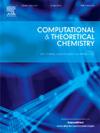Study of electrochemical properties, mechanical properties, and lithium ion diffusion of Ni and N co- doped LiFePO4 based on first principles
IF 3
3区 化学
Q3 CHEMISTRY, PHYSICAL
引用次数: 0
Abstract
This study analyzes the stability, volume change rate, embedding voltage, lithium ion diffusion, and mechanical properties of Ni, N co-doped LiFePO4 using density functional theory (DFT) calculations. Ni,N doping reduces formation energy to −1.5 eV compared to pristine LiFePO₄, stabilizing the olivine framework during lithiation/de-lithiation. The doping of Ni and N introduces impurity bands, and the band gap before and after doping decreases from 3.71 eV to 1.2 eV, which enhances the electronic conductivity. Meanwhile, the migration barrier is reduced from 0.57 eV to about 0.45 eV and the diffusion coefficient is improved by two orders of magnitude. In addition, nickel doping leads to changes in the local electronic structure, and the reduced electron localization helps the migration of lithium ions. Finally, doping enhances the stiffness, hardness of the material, which further improves its overall performance.

基于第一原理的镍和氮共掺杂磷酸铁锂的电化学特性、机械特性和锂离子扩散研究
本研究利用密度泛函理论(DFT)计算分析了Ni, N共掺杂LiFePO4的稳定性、体积变化率、嵌入电压、锂离子扩散和力学性能。与原始LiFePO₄相比,Ni,N掺杂将形成能降低至- 1.5 eV,在锂化/去锂化过程中稳定了橄榄石框架。Ni和N的掺杂引入了杂质带,掺杂前后的带隙从3.71 eV减小到1.2 eV,提高了电子导电性。同时,迁移势垒从0.57 eV降低到0.45 eV左右,扩散系数提高了两个数量级。此外,镍掺杂导致了局部电子结构的变化,电子局域化的降低有助于锂离子的迁移。最后,掺杂提高了材料的刚度、硬度,进一步提高了材料的综合性能。
本文章由计算机程序翻译,如有差异,请以英文原文为准。
求助全文
约1分钟内获得全文
求助全文
来源期刊

Computational and Theoretical Chemistry
CHEMISTRY, PHYSICAL-
CiteScore
4.20
自引率
10.70%
发文量
331
审稿时长
31 days
期刊介绍:
Computational and Theoretical Chemistry publishes high quality, original reports of significance in computational and theoretical chemistry including those that deal with problems of structure, properties, energetics, weak interactions, reaction mechanisms, catalysis, and reaction rates involving atoms, molecules, clusters, surfaces, and bulk matter.
 求助内容:
求助内容: 应助结果提醒方式:
应助结果提醒方式:


